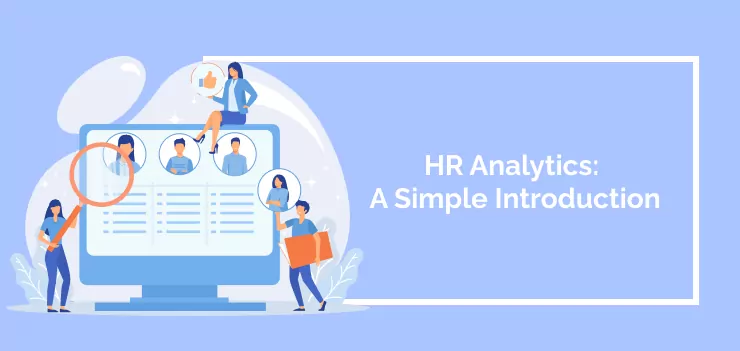
Why do you need a good HR analytics program in your business? To put it simply, HR analytics can support your work in any of the main functions of HR. It gives you a framework to collect data, perform data analysis, and support leaders in making data-driven decisions.
HR analytics is a skilled area of expertise with implications across theanalytic HR technology HR function. Analytics insights can impact workforce planning, recruitment, retention and churn prediction, performance management, employee engagement, learning and development, and more.
But the businesses of today aren’t utilizing HR analytics to the max. As we see in Oracle’s 2021 report on the State of HR Analytics, more than two-thirds of businesses use HR analytics effectively.
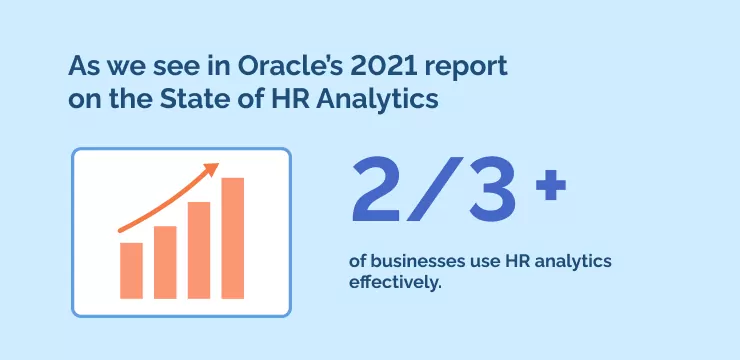
You’ve come to the right place if you’re wondering how to improve your company’s HR analytics capacities. This article will:
- Explain what HR analytics is
- Show how different types of data analytics enable HR professionals to make better decisions
- Describe the importance of HR analytics
- How to get started with data analytics in HR.
Whether worrying about change management, retention, or sustaining productivity, HR analytics is your friend.
What is HR analytics?
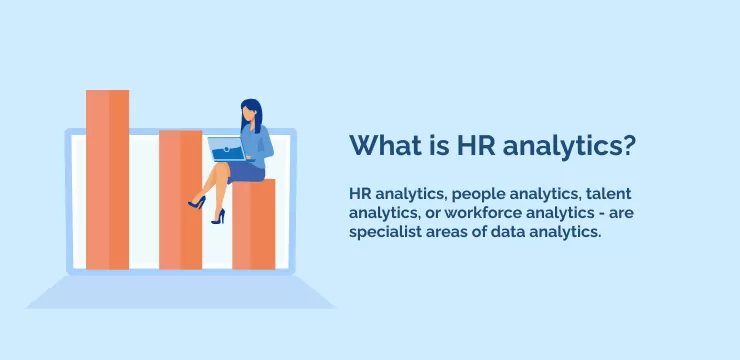
HR analytics, people analytics, talent analytics, or workforce analytics – are specialist areas of data analytics.
Data analytics professionals gather information from all around the company – including sales data, customer data, financial data, social media data, website analytics, and more. The process that information and use it to improve decisions around the company: in overall business performance, optimizing processes, enhancing customer experience, identifying market trends, and increasing profitability.
HR analytics is focused on data from human resources. HR systems, such as staff records, record important employee data. But data about people can be found across the organization in IT, sales, marketing, production, manufacturing, and creative services. External sources, such as industry-wide salaries or working conditions surveys, can be added to the HR analytics database.
A CIPD explainer from 2022 explains that there are three main aims of HR analytics:
- Improve decision-making by connecting people data with business data
- To get the best information for implementing HR activities.
- To measure HR’s effectiveness.
Let’s go deeper into data analytics by explaining the three major types of HR analytics.
The three types of HR analytics
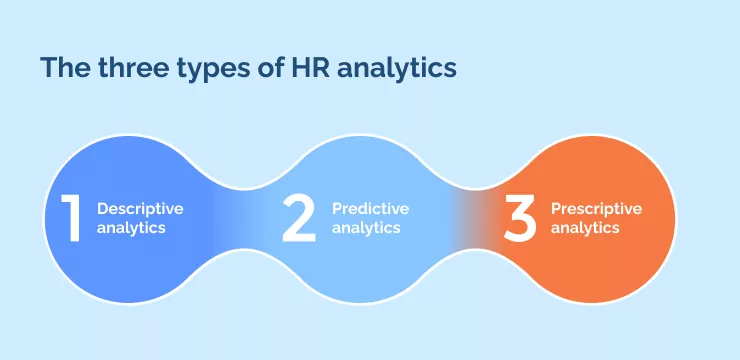
There are three main types of HR analytics: descriptive, predictive, and prescriptive. It is important to understand the difference so they can be used to their full potential. In short, these three types of HR analytics vary in depth and detail. They can be used to ensure the best quality data is gathered, analyzed, and used for organizational change and improvement.
Descriptive analytics
Perhaps the most basic level of analytics, descriptive analytics, use, as the name suggests, descriptive data to provide a picture of organizational health. Simple data, such as annual leave records, records for leave regarding factors such as illness or bereavement, staff retention and turnover, and recruitment rates.
When HR leaders take this often superficial data to the next level, deeper analysis can result in important insights. For example, when combined with analysis of staff turnover and reasons for resigning, intensive investigation of reasons for sick leave, such as stress, can help identify issues within an organization that requires remedying.
Predictive analytics
Descriptive analytics can help determine predictive analytics, but this level of analysis demands additional data to help organizations predict future trends. For example, external industry and labor market data could be used to determine factors that could affect an organization’s workforce planning and optimization processes.
If external data pointed towards a shortage of workers in a certain demographic, this could affect an organization’s ability to recruit people for growth. When such insights become apparent via predictive HR analytics, a business can take early actions to prevent staff shortages, such as additional staff training or casting the recruitment net to a wider geographical area.
Prescriptive analytics
This is where descriptive and predictive analytics results come together to automatically devise recommendations for change management and organizational improvements. This is perhaps the most powerful HR analytics type, but it requires investment in analytic HR technology.
Continuing from the above example regarding predicted staff shortages, prescriptive analytics could be engaged to automatically recommend training and development programs to upskill people who already work for the company or suggest recruitment solutions to find people outside the local area.
Why are HR analytics important?
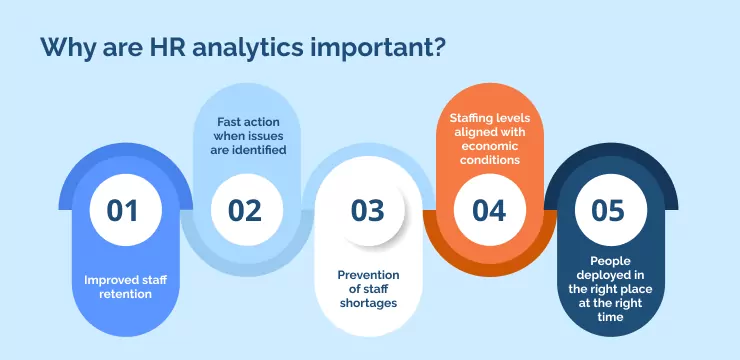
It is crucial that HR professionals can communicate to senior management about the importance of HR analytics. This is especially important when making a strong business case for investing in technology to facilitate the analysis process and, critically, take action as a result of the analysis.
The business case for introducing HR analytics and the associated technologies needs to focus on the real return on investment (ROI) that can be achieved. Workforce planning can then be taken to the next level.
HR analytics should provide organizations with the detailed insights needed to best manage employees and meet business goals – it is the ability to communicate these bottom-line benefits that come with a well-managed workforce that will lead to investment.
The sheer quantity of available data can be overwhelming, but when HR teams can, with the help of the right technology, identify which information is the most relevant and use it effectively, the ROI benefits are easily demonstrated.
Let’s look at some of the key benefits of HR analytics.
Improved staff retention
When HR analytics can effectively examine the reasons for workforce attrition, action can be taken before minor concerns become major problems. Data from exit interviews can be useful for this process.
Fast action when issues are identified
Improved staff retention is just one area where HR analytics can be used to ensure the bottom line is not affected. For example, if analysis of sick leave data reveals issues with many employees taking time off for stress-related reasons, this would be a good opportunity for an organization to take proactive steps to support employee mental health.
Prevention of staff shortages
HR analytics that considers wider industry data and detects major trends will stand an organization in good stead if it can avoid labor shortages. There can be several reasons for the labor shortage, including internal and external factors.
While descriptive data gathered within an organization can help prevent staff shortages, predictive data based on external factors can have a more powerful impact. If factors such as major demographic changes and immigration patterns can be analyzed in conjunction with internal data, costly staff shortages can be flagged early and more easily avoided.
Staffing levels aligned with economic conditions
Whether your organization has been experiencing tough financial times or you are in a period of growth and expansion, using HR analytics insights will help ensure staffing levels are optimized.
Staffing costs are generally one of the biggest expenses of any organization. Hence, using data constructively means the right balance can be struck between payroll expenditure and having enough people on board to meet productivity targets. Especially as businesses are adjusting to life after Covid, this aspect of business is more important than ever.
People deployed in the right place at the right time
Smart staffing is not just a numbers game. While it is important to have the right number of people working in your organization, it is equally important to ensure they are properly deployed. Are you getting the best value from your team?
HR analytics can provide the information you need to know about productivity levels and how every team member fills their working day. For example, data from a skills audit can be used to determine if everyone is in a role that best suits their skills.
Properly deployed people are generally more productive and happier, achieving the twin bottom-line benefits of high productivity and improved staff retention. It’s a win-win.
Getting started with HR data gathering
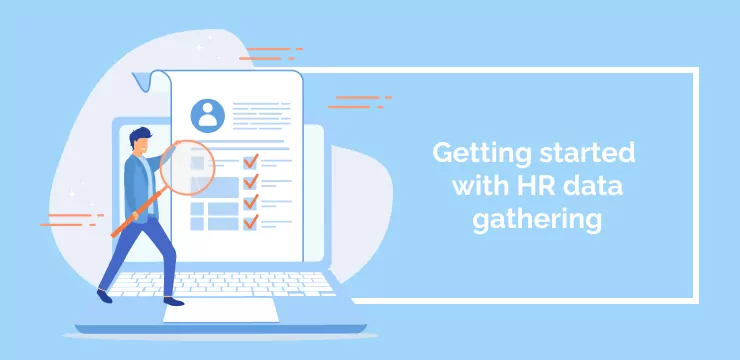
Starting the process of introducing HR analytics can seem daunting, especially when new technology has been introduced. Obtaining senior management buy-in to implement HR analytics and invest in the right solutions to optimize the process is just the beginning.
But data collection as part of a digital transformation process for the HR department can and should result in far-reaching, long-term, positive outcomes for the whole organization.
The three types of HR analytics data – descriptive, predictive, and prescriptive – are all important to the overall process. Ideally, all three types of data should be collected and analyzed in conjunction with each other to get the best possible insights.
Gathering descriptive data is the obvious place to start, especially as this is the most basic level of data, and it should be readily available in the records of most HR departments. On the surface, descriptive data is raw and might not seem particularly useful at first glance. What is important here is the process of aggregation and analysis.
When climbing the HR data mountain, starting with the absolute basics and building in more detail can be helpful. A headcount of all employees is a good place to begin. Once you have this raw figure, a simple number, you can start breaking it down into further categories, such as age, gender balance, and education and qualification levels.
Even this basic information will start to paint a picture of an organization, and important insights will begin to emerge. For example, if you discover that a significant proportion of your workforce is getting close to retirement age, you might consider developing a solid succession planning strategy.
More sophisticated and detailed metrics can be added from here to bolster the data, deepen insights, and catalyze positive workplace change. Turnover rates, for example, can be instructive when analyzed alongside the reasons for leaving. This is another example of descriptive analytics, so caution is needed because such data focus on the things that have already happened.
Solely focusing on descriptive analytics is not the most effective way to undertake a comprehensive HR analytics program because it tends to be reactive rather than proactive. This is why moving on to the more detailed, forward-looking metrics of predictive and prescriptive analytics is essential, which is vital for clear insights and better decision-making.
Taking the next step towards being proactive
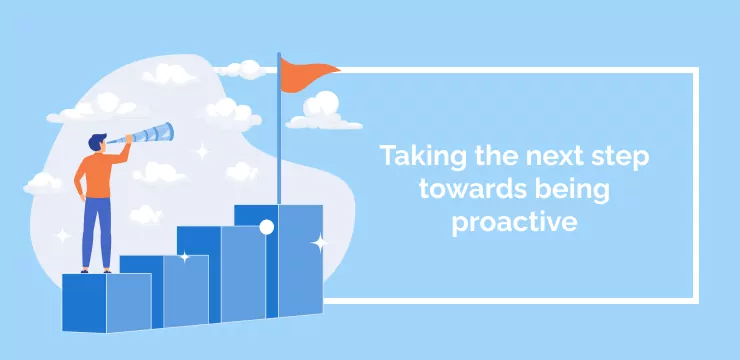
Predictive and prescriptive HR analytics will result in a more proactive approach that can evolve to align better with business needs.
Adding the next layer of analytics – the predictive and prescriptive layers – to the HR datasets can be as overwhelming as getting started with the basic descriptive data gathering and aggregation. But there are two key ways to overcome the big data fear, take a deep dive into more advanced HR analytics and reap the benefits.
Bring on the technology!
If you have made a strong business case for technology investment, now is the time to be fearless. Digital transformation has an incredible impact across all industries and departments within organizations – and HR should be no exception. If you are unsure how to get started with the right technology for your organization’s needs, do not be afraid to ask for help.
Different companies have different needs, depending on a wide range of factors, including the size of the workforce, type of industry, and quality of internet access. But when you have found the right technology and are comfortable using it, the sky’s the limit in terms of what can be achieved.
Keep your eyes on the prize
Whenever the digital transformation process seems difficult, remind yourself of the myriad benefits. As well as the financial benefits that led to making the business case for technological development in the first place, do not forget the benefits of having a happier, more productive workforce with employees who look forward to coming to work.
Predictive and prescriptive analytics requires an extra commitment to digital transformation, but when you realize you can do things such as help determine if potential employees will be a good cultural fit before they are hired or spot opportunities to offer extra training to advance the careers of junior team members. Technology is available now to help make predictions, such as how long new hires might stay with the organization.
The power of workforce analytics
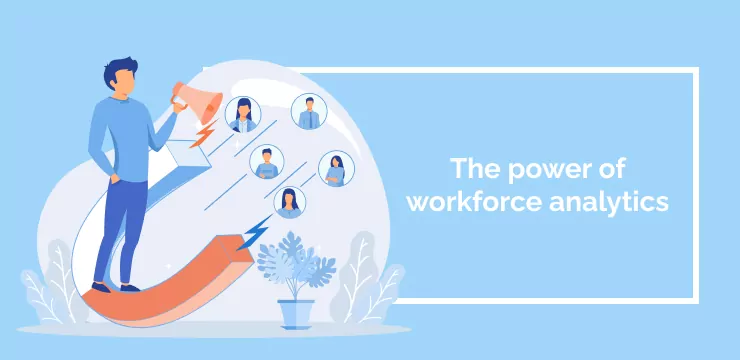
In this age of data-driven decision-making, knowledge is power. Information has become an incredibly valuable commodity. Everything from market intelligence to insights about how an aging population might affect your workforce can be gathered and analyzed so your organization can be continually proactive and dynamic.
So let’s have a quick recap.
- HR analytics is a form of data analytics that focuses on HR metrics. It may gather data on employee on employee productivity, performance, and other key metrics.
- HR Analytics can be divided into three sub-disciplines: predictive HR analytics, predictive HR analytics, and prescriptive HR analytics.
- The outputs from HR analytics can improve many aspects of human experiences in your company.
- Using HR analytics tools to analyze the data collected is a great step toward a successful data-driven program.
You might find that hiring data scientists for your HR team could help you move your program forward: not only understanding the simple definition of HR analytics but being empowered to use technology to take the HR analytics process to great heights could have a major impact on your business outcomes.
Technology should be your friend during this process. What might seem like a daunting task, especially in larger organizations, can become genuinely meaningful with multiple benefits if the right HR analytics software is leveraged to meet your needs to save time and money and create an organization that is driven by solutions rather than being in a constant cycle of reactive crisis management.
At its best, adopting a forward-thinking, proactive approach to HR analytics will improve employee engagement across every level of the organization and boost business.
WalkMe Team
WalkMe spearheaded the Digital Adoption Platform (DAP) for associations to use the maximum capacity of their advanced resources. Utilizing man-made consciousness, AI, and context-oriented direction, WalkMe adds a powerful UI layer to raise the computerized proficiency, everything being equal.



